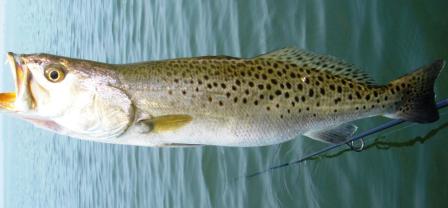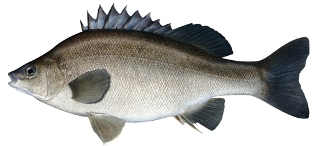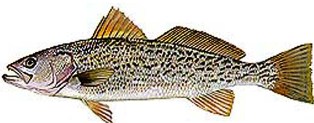Discover Florida Nature
It's time to explore the natural Florida


|
|
|
|
|
 Spotted
Seatrout (Cynoscion nebulosus) Spotted seatrout males
average 19 inches in length. Females are 25 inches long on average.
Males and females weigh 2 to 3 pounds. Distinguishing characteristics of
the spotted seatrout include a dark gray or green back and silvery-white
below, with distinct round spots on back, fins and tail; black margin
along the edge of tail; soft dorsal (back) fin with no scales; and one
or two prominent canine teeth usually present at the tip of the upper
jaw. Small trout feed primarily on small crustaceans. Medium-size trout
feed on shrimp and small fish. Large fish feed almost exclusively on
other fish. Predators of the spotted seatrout include alligator gar,
striped bass, Atlantic croaker, tarpon and barracuda. Spotted seatrout
swim near seagrass beds of shallow bays and estuaries during spring and
summer, looking for prey. As water temperatures decline during fall,
they move into deeper bay waters and the Gulf of Mexico. As water
temperatures warm in the spring, the fish return to the shallows of the
primary and secondary bays. Spotted seatrout prefer shallower bays and
estuaries with oyster beds and seagrass beds that attract prey species.
It occurs in the western Atlantic and Gulf of Mexico, ranging from
Massachusetts to the Yucatan peninsula. Spotted seatrout are most common
in the shallow bays during spring and summer. As water temperatures
decline during fall, fish move into deeper bay waters and the Gulf of
Mexico. As water temperatures warm in the spring the spotted seatrout
move back into the shallows of the primary and secondary bays. During
periods of low rainfall and runoff, many trout often move into deeper
rivers and bayous with the first cool weather of fall. Similar
concentrations occur at dredged boat harbors and channels. Spotted
Seatrout (Cynoscion nebulosus) Spotted seatrout males
average 19 inches in length. Females are 25 inches long on average.
Males and females weigh 2 to 3 pounds. Distinguishing characteristics of
the spotted seatrout include a dark gray or green back and silvery-white
below, with distinct round spots on back, fins and tail; black margin
along the edge of tail; soft dorsal (back) fin with no scales; and one
or two prominent canine teeth usually present at the tip of the upper
jaw. Small trout feed primarily on small crustaceans. Medium-size trout
feed on shrimp and small fish. Large fish feed almost exclusively on
other fish. Predators of the spotted seatrout include alligator gar,
striped bass, Atlantic croaker, tarpon and barracuda. Spotted seatrout
swim near seagrass beds of shallow bays and estuaries during spring and
summer, looking for prey. As water temperatures decline during fall,
they move into deeper bay waters and the Gulf of Mexico. As water
temperatures warm in the spring, the fish return to the shallows of the
primary and secondary bays. Spotted seatrout prefer shallower bays and
estuaries with oyster beds and seagrass beds that attract prey species.
It occurs in the western Atlantic and Gulf of Mexico, ranging from
Massachusetts to the Yucatan peninsula. Spotted seatrout are most common
in the shallow bays during spring and summer. As water temperatures
decline during fall, fish move into deeper bay waters and the Gulf of
Mexico. As water temperatures warm in the spring the spotted seatrout
move back into the shallows of the primary and secondary bays. During
periods of low rainfall and runoff, many trout often move into deeper
rivers and bayous with the first cool weather of fall. Similar
concentrations occur at dredged boat harbors and channels. Silver
Perch (yellowtail) (Bairdiella chrysoura) Widespread
on the eastern seaboard, the silver perch is commonly caught by inshore
anglers in search of larger species. The silver perch is a small silvery
drumfish often mistaken for white perch; found along coasts of United
States from New York to Mexico. Silver perch moves in schools, and when
in the mood will dart at the bait in the liveliest manner, sometimes
springing entirely out of the water when seeing it. An excellent
fighting fish, silver perch are a popular target for many anglers.
Because of their small mouth, smaller baits and lures a best. The best
bait to catch silver perch is by far is freshwater shrimp, followed by
scrubworms. The Florida record for the yellowtail is ten pounds, with
the average weight being two to three pounds. Rarely attains a length of
nine inches or more, the silver perch are an underutilized resource as
they are excellent table fare and a welcome addition to any Southern
fall fish fry Silver
Perch (yellowtail) (Bairdiella chrysoura) Widespread
on the eastern seaboard, the silver perch is commonly caught by inshore
anglers in search of larger species. The silver perch is a small silvery
drumfish often mistaken for white perch; found along coasts of United
States from New York to Mexico. Silver perch moves in schools, and when
in the mood will dart at the bait in the liveliest manner, sometimes
springing entirely out of the water when seeing it. An excellent
fighting fish, silver perch are a popular target for many anglers.
Because of their small mouth, smaller baits and lures a best. The best
bait to catch silver perch is by far is freshwater shrimp, followed by
scrubworms. The Florida record for the yellowtail is ten pounds, with
the average weight being two to three pounds. Rarely attains a length of
nine inches or more, the silver perch are an underutilized resource as
they are excellent table fare and a welcome addition to any Southern
fall fish fry Weakfish
(Cynoscion regalis) The weakfish is a sleek-bodied fish with a
dark olive back, iridescent blue and copper sides, and a silvery white
belly. The weakfish is a slim, shapely fish, about four times as long as
deep (to the base of the caudal fin), only slightly flattened sidewise,
with rather stout caudal peduncle; a head about one-third as long as
body, moderately pointed snout, and large mouth. Its upper jaw is armed
with two large canine teeth and its lower jaw projects beyond the upper.
The first dorsal fin (10 spines), originating a little behind the
pectorals, is triangular; the second dorsal (26 to 29 rays), originating
close behind the first, is more than twice as long as the first and
roughly rectangular. Weakfish move in schools, often small but sometimes
consisting of many thousands. Weakfish spawn from April through August
in nearshore waters near the mouth of the Chesapeake Bay. The name
"weakfish" comes from the fish's fragile mouth, which tears easily when
hooked by fishermen. Weakfish can live as long as nine years. Weakfish
stocks are down to an all-time low of just 2.9 million pounds along its
range from Massachusetts through Florida. To put this in perspective,
the East Coast harvest in 1980 was 80 million pounds. It was at 31
million pounds in 1986 but had slipped to 8 million pounds in 1993.
Researchers have no idea why these fish are not coming back each year,
but think it's a good possibility that a predator like striped bass,
bluefish or spiny dogfish (shark) is to blame. The commission also is
looking at environmental changes as another reason for the decline. Weakfish
(Cynoscion regalis) The weakfish is a sleek-bodied fish with a
dark olive back, iridescent blue and copper sides, and a silvery white
belly. The weakfish is a slim, shapely fish, about four times as long as
deep (to the base of the caudal fin), only slightly flattened sidewise,
with rather stout caudal peduncle; a head about one-third as long as
body, moderately pointed snout, and large mouth. Its upper jaw is armed
with two large canine teeth and its lower jaw projects beyond the upper.
The first dorsal fin (10 spines), originating a little behind the
pectorals, is triangular; the second dorsal (26 to 29 rays), originating
close behind the first, is more than twice as long as the first and
roughly rectangular. Weakfish move in schools, often small but sometimes
consisting of many thousands. Weakfish spawn from April through August
in nearshore waters near the mouth of the Chesapeake Bay. The name
"weakfish" comes from the fish's fragile mouth, which tears easily when
hooked by fishermen. Weakfish can live as long as nine years. Weakfish
stocks are down to an all-time low of just 2.9 million pounds along its
range from Massachusetts through Florida. To put this in perspective,
the East Coast harvest in 1980 was 80 million pounds. It was at 31
million pounds in 1986 but had slipped to 8 million pounds in 1993.
Researchers have no idea why these fish are not coming back each year,
but think it's a good possibility that a predator like striped bass,
bluefish or spiny dogfish (shark) is to blame. The commission also is
looking at environmental changes as another reason for the decline.
|
|
|
Advertise | Privacy Statement | Contact | Alaska Nature | Michael Arnold Art| Dog Encyclopedia | Dog Encyclopedia| |
|